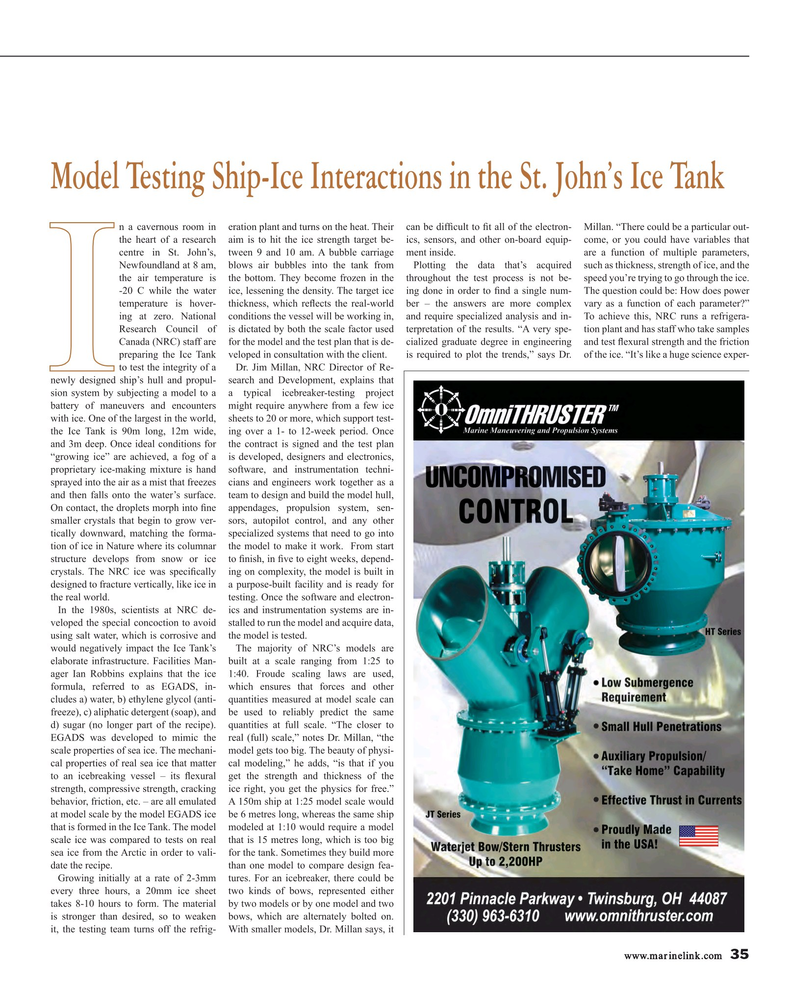
Page 35: of Maritime Reporter Magazine (February 2017)
The Cruise Industry Edition
Read this page in Pdf, Flash or Html5 edition of February 2017 Maritime Reporter Magazine
Model Testing Ship-Ice Interactions in the St. John’s Ice Tank n a cavernous room in eration plant and turns on the heat. Their can be dif? cult to ? t all of the electron- Millan. “There could be a particular out- the heart of a research aim is to hit the ice strength target be- ics, sensors, and other on-board equip- come, or you could have variables that centre in St. John’s, tween 9 and 10 am. A bubble carriage ment inside. are a function of multiple parameters,
Newfoundland at 8 am, blows air bubbles into the tank from Plotting the data that’s acquired such as thickness, strength of ice, and the the air temperature is the bottom. They become frozen in the throughout the test process is not be- speed you’re trying to go through the ice. -20 C while the water ice, lessening the density. The target ice ing done in order to ? nd a single num- The question could be: How does power temperature is hover- thickness, which re? ects the real-world ber – the answers are more complex vary as a function of each parameter?” ing at zero. National conditions the vessel will be working in, and require specialized analysis and in- To achieve this, NRC runs a refrigera-
Research Council of is dictated by both the scale factor used terpretation of the results. “A very spe- tion plant and has staff who take samples
Canada (NRC) staff are for the model and the test plan that is de- cialized graduate degree in engineering and test ? exural strength and the friction preparing the Ice Tank veloped in consultation with the client. is required to plot the trends,” says Dr. of the ice. “It’s like a huge science exper- to test the integrity of a Dr. Jim Millan, NRC Director of Re-
I I newly designed ship’s hull and propul- search and Development, explains that sion system by subjecting a model to a a typical icebreaker-testing project battery of maneuvers and encounters might require anywhere from a few ice with ice. One of the largest in the world, sheets to 20 or more, which support test- the Ice Tank is 90m long, 12m wide, ing over a 1- to 12-week period. Once and 3m deep. Once ideal conditions for the contract is signed and the test plan “growing ice” are achieved, a fog of a is developed, designers and electronics, proprietary ice-making mixture is hand software, and instrumentation techni- sprayed into the air as a mist that freezes cians and engineers work together as a and then falls onto the water’s surface. team to design and build the model hull,
On contact, the droplets morph into ? ne appendages, propulsion system, sen- smaller crystals that begin to grow ver- sors, autopilot control, and any other tically downward, matching the forma- specialized systems that need to go into tion of ice in Nature where its columnar the model to make it work. From start structure develops from snow or ice to ? nish, in ? ve to eight weeks, depend- crystals. The NRC ice was speci? cally ing on complexity, the model is built in designed to fracture vertically, like ice in a purpose-built facility and is ready for the real world. testing. Once the software and electron-
In the 1980s, scientists at NRC de- ics and instrumentation systems are in- veloped the special concoction to avoid stalled to run the model and acquire data, using salt water, which is corrosive and the model is tested.
would negatively impact the Ice Tank’s The majority of NRC’s models are elaborate infrastructure. Facilities Man- built at a scale ranging from 1:25 to ager Ian Robbins explains that the ice 1:40. Froude scaling laws are used, formula, referred to as EGADS, in- which ensures that forces and other cludes a) water, b) ethylene glycol (anti- quantities measured at model scale can freeze), c) aliphatic detergent (soap), and be used to reliably predict the same d) sugar (no longer part of the recipe). quantities at full scale. “The closer to
EGADS was developed to mimic the real (full) scale,” notes Dr. Millan, “the scale properties of sea ice. The mechani- model gets too big. The beauty of physi- cal properties of real sea ice that matter cal modeling,” he adds, “is that if you to an icebreaking vessel – its ? exural get the strength and thickness of the strength, compressive strength, cracking ice right, you get the physics for free.” behavior, friction, etc. – are all emulated A 150m ship at 1:25 model scale would at model scale by the model EGADS ice be 6 metres long, whereas the same ship that is formed in the Ice Tank. The model modeled at 1:10 would require a model scale ice was compared to tests on real that is 15 metres long, which is too big sea ice from the Arctic in order to vali- for the tank. Sometimes they build more date the recipe. than one model to compare design fea-
Growing initially at a rate of 2-3mm tures. For an icebreaker, there could be every three hours, a 20mm ice sheet two kinds of bows, represented either takes 8-10 hours to form. The material by two models or by one model and two is stronger than desired, so to weaken bows, which are alternately bolted on. it, the testing team turns off the refrig- With smaller models, Dr. Millan says, it www.marinelink.com 35
MR #2 (34-41).indd 35 MR #2 (34-41).indd 35 2/6/2017 11:00:45 AM2/6/2017 11:00:45 AM

 34
34

 36
36
